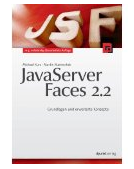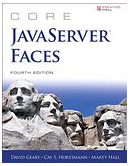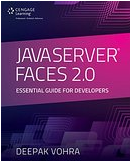The <h:inputHidden> renders an HTML "input" element of "type" "hidden"
Common/basic
usage in JSF (I):
<?xml
version='1.0' encoding='UTF-8' ?>
<!DOCTYPE
html PUBLIC "-//W3C//DTD XHTML 1.0 Transitional//EN"
"http://www.w3.org/TR/xhtml1/DTD/xhtml1-transitional.dtd">
<html
xmlns="http://www.w3.org/1999/xhtml"
xmlns:h="http://xmlns.jcp.org/jsf/html">
<h:head>
<title>JSF inputHidden
examples</title>
</h:head>
<h:body>
<h:form>
Name:
<h:inputText value="#{playerBean.name}"/>
<h:inputHidden value="#{playerBean.age}"/>
<h:commandButton value="Send" action="data"/>
</h:form>
</h:body>
</html>
The <h:inputHidden>
will be rendered in HTML as:
<input
type="hidden" name="j_idt6:j_idt9" value="0"
/>
The PlayerBean
will be:
package
beans;
import
java.io.Serializable;
import
javax.enterprise.context.SessionScoped;
import
javax.inject.Named;
@Named
@SessionScoped
public class
PlayerBean implements Serializable {
private String name = "Rafael
Nadal";
private String age = "0";
public String getName() {
return name;
}
public void setName(String name) {
this.name = name;
}
public String getAge() {
return age;
}
public void setAge(String age) {
this.age = age;
}
}
At initial
request, the hidden value is initialized from bean with 0 (the default value of
age
field). The hidden value is not modified in page, so, at postback, the hidden
value will still be 0.
The data.xhtml
page is:
<?xml
version='1.0' encoding='UTF-8' ?>
<!DOCTYPE
html PUBLIC "-//W3C//DTD XHTML 1.0 Transitional//EN"
"http://www.w3.org/TR/xhtml1/DTD/xhtml1-transitional.dtd">
<html
xmlns="http://www.w3.org/1999/xhtml"
xmlns:h="http://xmlns.jcp.org/jsf/html">
<h:head>
<title></title>
</h:head>
<h:body>
<!-- View submitted data -->
Name: <h:outputText
value="#{playerBean.name}"/><br/>
Age: <h:outputText value="#{playerBean.age}"/><br/>
</h:body>
</html>
Data flow in
image:
More examples:
Commonly, the above example is the "skeleton" behind one of the next two use cases.
Use case 1 - you may need
a hidden value in page - in this case, you can "extract"
it via a snippet of JavaScript, as below:
<!-- Get
in JavaScript the value of a JSF hidden value -->
<h:form
id="formId1">
Name: <h:inputText
id="playerNameId1" value="#{playerBean.name}"/>
<h:inputHidden id="playerAgeId1"
value="#{playerBean.age}"/>
<h:commandButton value="Send"
action="data" onclick="getHiddenAge();"/>
</h:form>
When the Send
button is clicked, before the form is submitted, the JavaScript getHiddenAge()
method is invoked. This time, we just alert the hidden value, but you can use
it to influence the submitted form values:
<script
type="text/javascript">
function getHiddenAge() {
alert("The hidden age is: " +
document.getElementById("formId1:playerAgeId1").value);
}
</script>
Use case 2 - sometimes, you need to alter the hidden value based on some conditions - for example, you can set the hidden value depending on player name. Again, a snippet of JavaScript will be helpful:
<!-- Pass
to a bean a new hidden value using a JSF hidden field and a snippet of
JavaScript -->
<h:form
id="formId2">
Name: <h:inputText
id="playerNameId2" value="#{playerBean.name}"/>
<h:inputHidden id="playerAgeId2"
value="#{playerBean.age}"/>
<h:commandButton value="Send"
action="data" onclick="setHiddenAge();"/>
</h:form>
The hidden
value is initialized form bean with 0, but the setHiddenAge() method will
modify its value before submitting the form, based on the player name:
<script
type="text/javascript">
function setHiddenAge() {
var playername =
document.getElementById("formId2:playerNameId2").value;
if (playername === "David Ferrer")
{
document.getElementById("formId2:playerAgeId2").value
= "32";
} else if (playername === "Andy
Murray") {
document.getElementById("formId2:playerAgeId2").value =
"27";
} else
{
document.getElementById("formId2:playerAgeId2").value
= "28";
}
}
</script>
Further, let's see a dummy case of using the <h:inputHidden>
<?xml
version='1.0' encoding='UTF-8' ?>
<!DOCTYPE
html PUBLIC "-//W3C//DTD XHTML 1.0 Transitional//EN"
"http://www.w3.org/TR/xhtml1/DTD/xhtml1-transitional.dtd">
<html
xmlns="http://www.w3.org/1999/xhtml"
xmlns:pt="http://xmlns.jcp.org/jsf/passthrough"
xmlns:h="http://xmlns.jcp.org/jsf/html">
<h:head>
<title>JSF inputHidden
examples</title>
</h:head>
<h:body>
<h:form
id="formId3">
Name:
<h:inputText value="#{playerBean.name}"/>
<h:inputHidden id="playerage3" value="28"/>
<h:commandButton value="Send"
action="#{playerBean.save1()}"/>
</h:form>
</h:body>
</html>
The <h:inputHidden>
will be rendered in HTML as:
<input
id="formId3:playerage3" type="hidden"
name="formId3:playerage3" value="28" />
The PlayerBean
will be:
package
beans;
import
java.io.Serializable;
import javax.enterprise.context.SessionScoped;
import
javax.faces.context.FacesContext;
import
javax.inject.Named;
@Named
@SessionScoped
public class
PlayerBean implements Serializable {
private String name = "Rafael
Nadal";
private String age = "0";
public String save1() {
// extract the hidden value from request
parameter map
String playerage =
FacesContext.getCurrentInstance().getExternalContext().getRequestParameterMap().get("formId3:playerage3");
// print the extracted value
System.out.println("Player age: " + playerage);
// set the bean field, 'age', equal to the
extracted value
this.age = playerage;
// navigate to 'data.xhtml' page
return "data";
}
public String getName() {
return name;
}
public void setName(String name) {
this.name = name;
}
public String getAge() {
return age;
}
public void setAge(String age) {
this.age = age;
}
}
In PlayerBean,
we can easily extract the hidden value from the request parameter map - the JSF
getRequestParameterMap()
method returns the submitted request parameters as a Map of type parameter name = parameter value (the
parameter name represents the component clientId
generated by JSF (e.g. formId1:playerage1)). This map can be
inspected in browser via specialized tools - for example, in Mozilla Firefox,
the request parameter map will be (the hidden field was highlighted):
We need to
use the getRequestParameterMap()
method, because the hidden value was hard coded in page, it wasn't linked to a
bean field via a ValueExpression. The hidden value is used to set the bean
field, age,
right inside the bean (manually in the save1() method). Further, the
application navigates to another page, named, data.xhtml:
<?xml
version='1.0' encoding='UTF-8' ?>
<!DOCTYPE
html PUBLIC "-//W3C//DTD XHTML 1.0 Transitional//EN"
"http://www.w3.org/TR/xhtml1/DTD/xhtml1-transitional.dtd">
<html
xmlns="http://www.w3.org/1999/xhtml"
xmlns:h="http://xmlns.jcp.org/jsf/html">
<h:head>
<title></title>
</h:head>
<h:body>
<!-- View submitted data -->
Name: <h:outputText
value="#{playerBean.name}"/><br/>
Age: <h:outputText value="#{playerBean.age}"/><br/>
</h:body>
</html>
Data flow in
image:
Note In
the above example we have hard coded the hidden value. This is a pretty dummy
usage, because we don't exploit the JSF component itself. Basically, in such
cases, we can achieve the same thing by replacing the <h:inputHidden>
with the HTML markup, as below:
<!-- Pass
to a bean a new hidden value using the HTML markup instead of JSF hidden field
-->
<h:form
id="formId4">
Name: <h:inputText
value="#{playerBean.name}"/>
<input type="hidden"
id="playerage4" name="playerage4" value="28"
/>
<h:commandButton value="Send"
action="#{playerBean.save2()}"/>
</h:form>
This time
the save2()
method has a slight, but important, modification. Since this is plain HTML, we don't
have a clientId (JSF generates this
for JSF components only, not for plain HTML elements), we simply use the ID, playerage4:
public String save2() {
// extract the hidden value from request
parameter map
String playerage = FacesContext.getCurrentInstance().getExternalContext().getRequestParameterMap().get("playerage4");
// print the extracted value
System.out.println("Player age: " +
playerage);
// set the bean field, 'age', equal to the
extracted value
this.age = playerage;
// navigate to 'data.xhtml' page
return "data";
}
Complete source code on GitHub.
See also Mkyong.com.
More resources on Constantin Alin, ZEEF page.
InputHidden in JSF Extension on JSF ShowCase ZEEF page.











 Arrays
Arrays Converters
Converters



 JSF 2 Tutorials at www.mkyong.com
JSF 2 Tutorials at www.mkyong.com  JavaServer Faces (JSF) Tutorial
JavaServer Faces (JSF) Tutorial 





















Niciun comentariu :
Trimiteți un comentariu